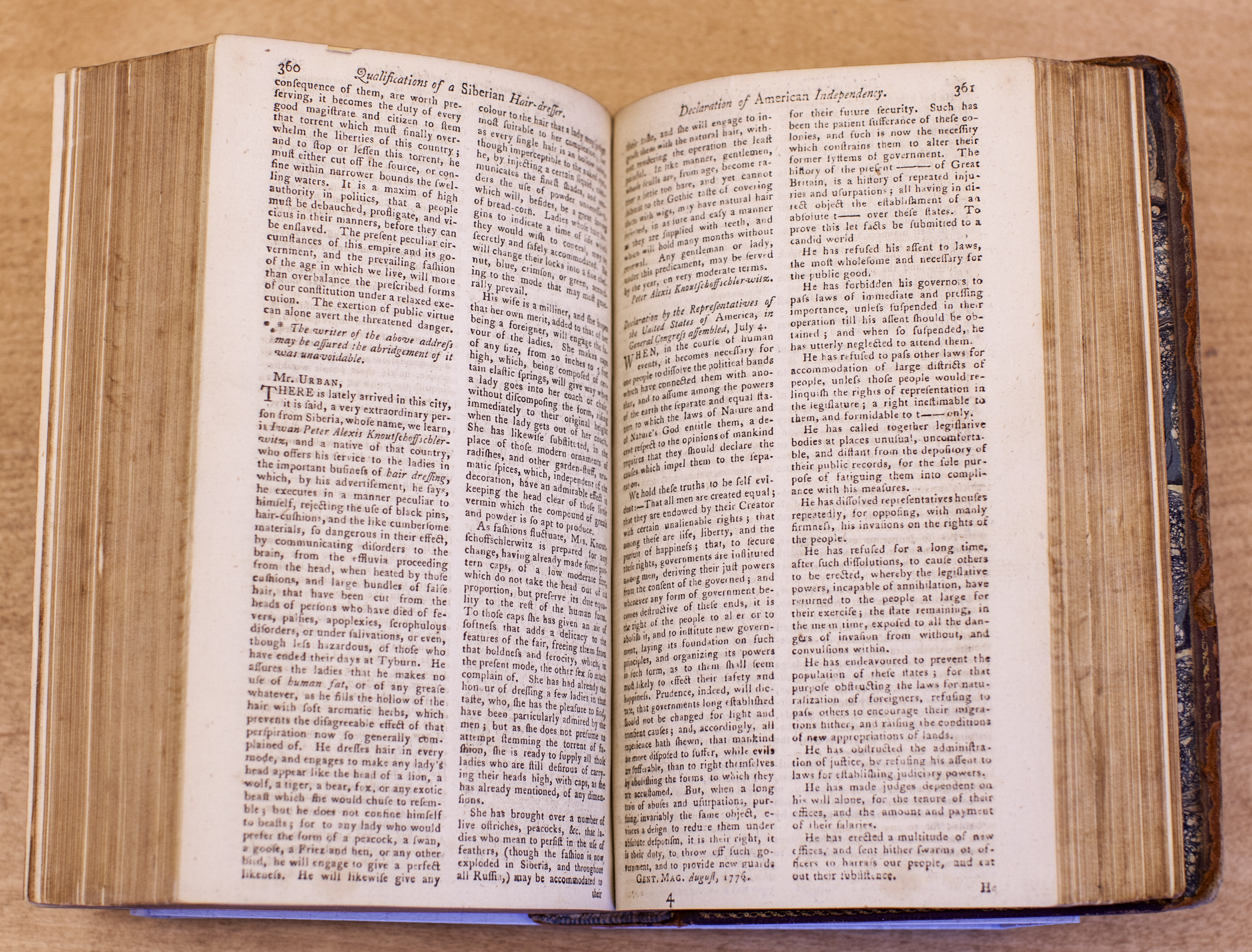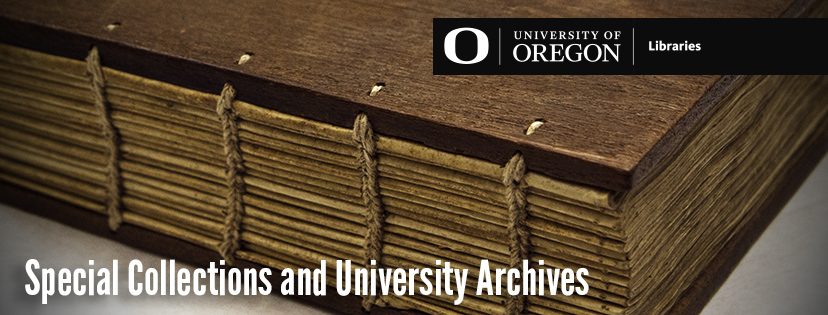Reports of Independency Abroad: The Declaration of Independence in the Gentleman’s Magazine
Special Collections and University Archives at the UO Library holds a very rare, and often cited as the first, British printing of the Declaration of Independence in a complete copy of the 1776 Gentleman’s Magazine. This volume is one of 302 volumes of the Gentleman’s Magazine in the Rare Book Collection, dating between the magazine’s inception in 1731 to 1907 (which ceased production in 1922).
News of the Continental Congress’s vote for independency reached the British public on August 10, 1776. The Crown-sponsored London Gazette delivered the breaking news through excerpts of two letters from General William Howe dated July 7th and 8th. Howe writes,
I am informed that the Continental Congress have declared the United Colonies free and independent States.
The majority of the British public, however, would not be able to read the full Declaration approved by the Continental Congress until August 17th, when the Declaration was reprinted by the London Chronicle in its August 16th paper (the first newspaper to deliver the news is debated, other contenders for delivering the Declaration on the 16th include Public Advertiser, Lloyd’s Evening Post, and British Chronicle). The full text of the Declaration of Independence was first typeset and printed in John Dunlap’s Philadelphia print shop on July 5th and made available for distribution, though it is unclear by exactly what means Dunlap’s broadside reached the press in Great Britain.
In addition to newspapers, monthly periodicals across Great Britain reprinted the Declaration of Independence. One of the first of these included the Gentleman’s Magazine run by Edward Cave under the editorial pen name, Sylvanus Urban, from his home at St. John’s Gate. Cave’s periodical is credited with being the first in English to employ the French term “magazine.” The Magazine was a digest of news and literature for an educated public, and notably employed Samuel Johnson as a writer.

In the August 1776 edition of Gentleman’s Magazine, the list of contents points to the “Declaration of American Independency” on page 361 between articles on “qualifications of a Siberian hair-dresser” and a “report of the committee appointed to enquire into the state of the city’s cash.”

The Gentleman’s Magazine printing of the Declaration ends with the printed signatures of John Hancock and Charles Thompson. The document is presented in its entirety, but with some of its contents censured. References to “King” and “Prince” are replaced with a line “_______.” Any mention of “tyranny or “tyrant” are similarly obscured by the typesetter as “t_______.”

Later in the magazine in the recurring section “Proceedings of the American Colonies,” the editor makes some remarks on the Declaration (as well as reprints the aforementioned Howe letters dated July 7 and 8). The editor writes:
In the preceding part of this magazine the reader will find the Declaration of Independency issued by the American Congress, with a recapitulation of the grievances which have forced them into that desperate measure. Whether those grievances were real or imaginary, or whether they did or did not deserve a parliamentary enquiry, we will not presume to decide. The ball is now struck, and time only can shew where it will rest.
Early British responses to the Declaration varied from contempt for its stated ideological platform of equality to anger over ungratefulness of British protection. In the following months, a variety of opinions on the American Declaration of Independence were printed in the Gentleman’s Magazine. After reprinting a sharply critical letter by ‘An Englishman’ in September, the October edition of the Gentleman’s Magazine printed a response to the ‘Englishman’ by ‘Philander’ of ‘High Wycomb,’ who stated he was ashamed to be a fellow citizen because the ‘Englishman’ did not place a high value on natural rights. There was no unified British response to the American move for independency.
In addition to the prestigious engrossed copy of the Declaration of Independence on display at the National Archives, printed and manuscript copies of this document are highly prized. Manuscript copies are rare, but recently include a parchment example uncovered in a West Sussex record office.

By Alexa Goff, Special Collections and University Archives Student Collections Assistant
Sources:
Carlson, Carl Lennart. The First Magazine; a History of the Gentleman’s Magazine, with an Account of Dr. Johnson’s Editorial Activity and of the Notice given America in the Magazine. Providence, R.I.: Brown University, 1938.
Matyas, Stephen M. Declaration of Independence: A Checklist of Books, Pamphlets, and Periodicals Printing the U.S. Declaration of Independence, 1776-1825: With an Appendix Checklist of American Newspapers Printing the Declaration of Independence. Haymarket, Virginia: 2009.–Gentleman’s Magazine is 76-05 on the checklist
Peckham, Howard H. “Independence: The View from Britain.” In The Declaration of Independence: Two Essays. Worcester [Mass.]: American Antiquarian Society, 1976.

